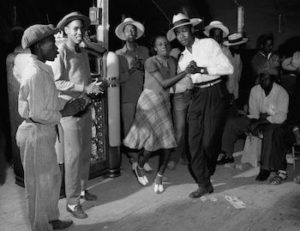
New Jersey, 1942
*This date is dedicated to African American Dance. Starting in the 1500s, Black Africans brought their dances to North, Central, and South America and the Caribbean Islands as slave labor. In the West, these dance styles of hundreds of Black ethnic groups merged with white dances, extending the African aesthetic in the Americas. Dance has always been an integral part of daily life in Africa. In the Americas, it helped enslaved Africans connect with their homeland, keeping their cultural traditions alive.
Before enslavement, Africans danced for many special occasions, such as a birth or a marriage, or as a part of their daily activities; dance affirmed life and the outlook of the future. After the Middle Passage, Africans in the Americas sang and danced while working as slaves. As they converted to the religions of white-Europeans and indigenous people, they incorporated these traditions into these cultures. Blacks who worked in the colonies of Spain, Portugal, the Caribbean, and South America were given more freedom to dance than enslaved Blacks in North America.
Many white-American slave owners barred Africans from most forms of dancing. As African instruments were outlawed, drums and early Stepping were created. Africans found ways of getting around these prohibitions. For example, since lifting the feet was considered dancing, many dances included foot shuffling and hip and torso movement. Dances dominant through the 18th century included the ring shout or ring dance, the calenda, the chica, and the juba. Asadata Defora and Master Juba were early practitioners.
The plantation dances moved onto the stage through Minstrel shows, which introduced Black dance to large audiences during the 1800s. As popular entertainment, both Blacks and whites performed them. Initially, Blacks appeared as caricatures that were often ridiculed, but they drew from their cultural traditions even as they made fun of themselves. In 1891, The Creole Show, a revue staged on Broadway, introduced The Cakewalk, the first American dance created by Blacks to become popular with whites. Other Black-influenced dance trends followed were the Charleston, the Lindy Hop, the Jitterbug, and the Twist. The 1920s and 1930s were an especially fruitful time for Black dance in the United States. Similar innovations in theater, music, literature and other arts during the Harlem Renaissance accompanied African American developments in dance. Black musical theater, derived from minstrel shows, continued to popularize and legitimize black dance traditions and performers, as it had in the 19th century.
Outstanding performances raised professional dance standards for Blacks and whites alike. “Shuffle Along,” a landmark Broadway show created by Blacks and with an all-Black cast, was immensely popular with white audiences. Many other all-Black shows, including “Runnin’ Wild,” “Chocolate Dandies,” and “Blackbirds” of 1928, also played to enthusiastic American audiences in the 1920s and 1930s. Tap combined elements of African-influenced shuffle dances, English clog dancing, and Irish jigs. Black dancers such as Bill Robinson brought a new form of respectability and popularity. Tap dancing developed further in the 1930s and 1940s when white dancers included it in motion pictures. During the 1930s and 1940s, Blacks moved into ballet and modern dance. Leading white choreographers integrated African American themes and movement styles into their dances and hired Blacks to perform them.
Also during this time, two American dancers trained as anthropologists, Katherine Dunham and Pearl Primus, made immeasurable contributions to African-influenced dance based on their research in Africa and the Caribbean. These dances fascinated audiences with their use of freely moving torsos, rhythmic vitality, native-influenced costumes, and highly energetic and enthusiastic performers. The Lester Horton Dance Theater and the Alvin Ailey American Dance Theater contributed significantly to modern dance. Other prominent Black choreographers and artistic directors include Donald McKayle, Debbie Allen, Talley Beatty, Garth Fagan, Bill T. Jones, Joel Hall, Virginia Johnson, and Robert Battle.
In recent years, several regional modern dance companies have been rich in innovations and connections with the past. The definition of dance has broadened to include the urban black dance forms of break dancing and hip-hop, which have been recognized for their artistry and expressiveness. All-female companies such as Urban Bush Women have been formed, as has a company devoted exclusively to hip-hop dance, The Pure Movement Dance Company. Tap dance found a new audience.
Female tap dancers, who once danced in relative obscurity, have also achieved recognition and encouragement. They highlight the legacy of women who have matched male tap dancers step by step. Dance created and performed by African Americans has become a permanent part of American dance. Contemporary dance companies founded by Blacks tour both nationally and internationally. These groups include the African American Dance Ensemble, Kan Kouran West African Dance Company, Ko-Thi Dance Company, Dinizulu, His African Dancers, Drummers, Singers, and Muntu Dance Theater.
The African American Desk Reference
Schomburg Center for Research in Black Culture
Copyright 1999 The Stonesong Press Inc. and
The New York Public Library, John Wiley & Sons, Inc. Pub.
ISBN 0-471-23924-0